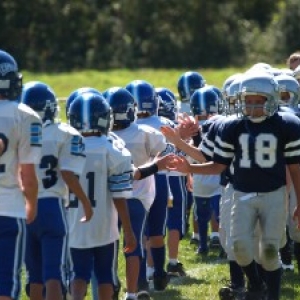Youth Football: The Pros Of Participating

It won’t be long until a crowd of kid quarterbacks break their huddles and launch a new youth football season, visions of touchdowns and glory — and perhaps postgame pizza — dancing in their heads. But making it into the end zone isn’t the end goal of youth football. While concerns about concussions and other injuries mount in the wake ofsome high-profile cases involving National Football League players, it’s important to note that there are many important benefits that come with participating at the youth level.
Putting Safety First
Before the benefits of playing youth football can be realized, parents have to be convinced their kids will be safe. Growing awareness about the prevalence of concussions among professional players in particular has rightly raised red flags:
- Concussion Watch, a PBS documentary series, found that 199 NFL players suffered concussions in 2015.
- More than 40 percent of retired NFL players showed signs of traumatic brain injury, based on MRI scans, according to a study presented earlier this year at the American Academy of Neurology’s annual meeting.
Youth football players, however, are not behemoths crashing into one another at seemingly blinding speeds. This, in fact, was recognized in a policy statement on tackling in youth football released last year by the American Academy of Pediatrics. In it, the group noted that some data suggested that youth football players suffer considerably fewer and less severe injuries than players of high school age and older. It also noted the incidence of injuries in football were similar to other sports (although football injuries often are more severe).
Reducing Injury Risks
Headfirst hits and helmet-to-helmet hits usually are the most dangerous for players of any age, and the American Academy of Pediatrics recommends a zero-tolerance policy for these hits for youth football leagues.

Although some risk of injury is inherent in playing any sport, there are numerous other ways to reduce that risk in youth football:
- Wear equipment with proper padding, and check it often
- Don’t play if you’re already hurt
- Don’t play tackle football until at least age 10
- Match teams based on the players’ size and skill, not strictly by age or grade level
- Address proper tackling and blocking techniques — and how to absorb tackles as well — during practices, while a coach can control the circumstances
- Ensure that players go through conditioning long before the season begins, and include neck strengthening
- Coaches should learn and be certified in first aid and CPR and undergo training to identify concussions
- Stay hydrated
- Warm up before practices and games, and stay loose on the sideline when not playing
- Have an athletic trainer available on the sideline
Youth football league officials may have all or many of these safeguards in place already, but with so much at stake, parents can take on the responsibility of checking up on safety practices. The American Academy of Pediatrics policy statement also recommended that more non-tackle leagues be created for those who don’t want to be exposed to the risks associated with playing tackle football.
The Pros of Participating
Nearly 4 million kids ages 6 to 14 played youth football in 2015, with 2.2 million of them participating in tackle football, according to USA Football, the sport’s national governing body. There’s no need to fumble for answers to determine why so many participate despite the injury risks. It’s because of the multitude of benefits: Character. Athletes regularly face adversity. Learning to bounce back from a bad play could translate some day into knowing how to recover from a bad day at the office. Sportsmanship. Losing isn’t fun on the field or in life. There is no benefit in throwing a tantrum, however. Likewise, there is nothing to gain by showing up or ridiculing an opponent when you win. Good efforts merit congratulations regardless of the outcome on the scoreboard.

Discipline. There are rules to follow, such as adhering to a coach’s instructions; and sacrifices to be made, such as taking steps to prepare the body to perform instead of playing video games and eating chips all day and night. Teamwork. In an increasingly global world, it is important to be able to work with and support others. In turn, being part of a team ensures that there’s always someone there to share in successes … and to commiserate with when things don’t go well. Role models. There are reasons many players stay in touch with their coaches even years after their shared game days are over. Youth football coaches make an impact on kids by teaching, inspiring and sacrificing their time. Physical fitness. Each position on a football team requires some combination of strength, speed and footwork. Love of the game. For some kids, youth football will become their first true passion. There will be give and take and ups and downs, and memories will be created that will last a lifetime.

